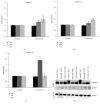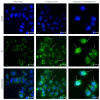The Induction of Apoptosis in A375 Malignant Melanoma Cells by Sutherlandia frutescens
- PMID: 27656236
- PMCID: PMC5021500
- DOI: 10.1155/2016/4921067
The Induction of Apoptosis in A375 Malignant Melanoma Cells by Sutherlandia frutescens
Abstract
Sutherlandia frutescens is a medicinal plant indigenous to Southern Africa and is commonly known as the "cancer bush." This plant has traditionally been used for the treatment of various ailments, although it is best known for its claims of activity against "internal" cancers. Here we report on its effect on melanoma cells. The aim of this study was to investigate whether an extract of S. frutescens could induce apoptosis in the A375 melanoma cell line and to outline the basic mechanism of action. S. frutescens extract induced apoptosis in A375 cells as evidenced by morphological features of apoptosis, phosphatidylserine exposure, nuclear condensation, caspase activation, and the release of cytochrome c from the mitochondria. Studies in the presence of a pan-caspase inhibitor allude to caspase-independent cell death, which appeared to be mediated by the apoptosis inducing factor. Taken together, the results of this study show that S. frutescens extract is effective in inducing apoptosis in malignant melanoma cells and indicates that further in vivo mechanistic studies may be warranted.
Figures










References
-
- Herbst M. C. Cancer Association of South Africa (CANSA) fact sheet on the top ten cancers per population. 2015, http://www.cansa.org.za/files/2015/05/Fact-Sheet-Top-Ten-Cancers-per-Pop....
LinkOut - more resources
Full Text Sources
Other Literature Sources

